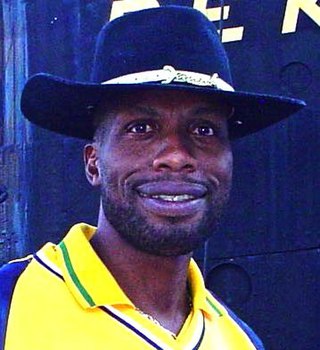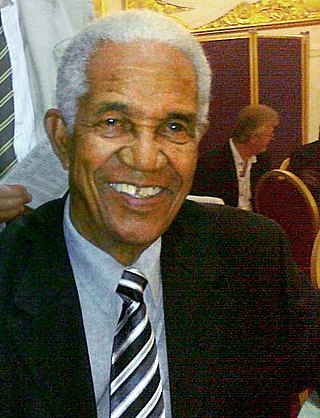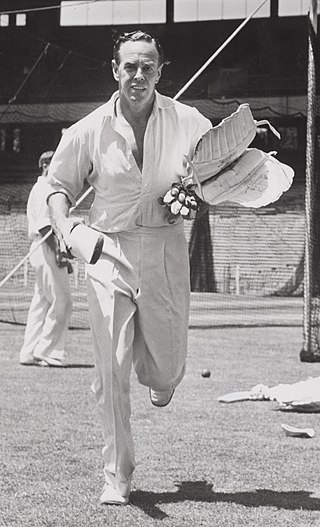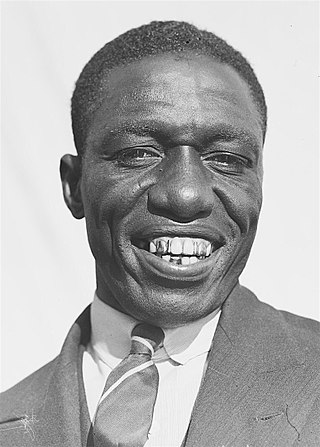Related Research Articles

Sir Curtly Elconn Lynwall Ambrose KCN is an Antiguan former cricketer who played 98 Test matches for the West Indies. Widely acknowledged as one of the greatest fast bowlers of all time, he took 405 Test wickets at an average of 20.99 and topped the ICC Player Rankings for much of his career to be rated the best bowler in the world. His great height—he is 6 feet 7 inches (2.01 m) tall—allowed him to make the ball bounce unusually high after he delivered it; allied to his pace and accuracy, it made him a very difficult bowler for batsmen to face. A man of few words during his career, he was notoriously reluctant to speak to journalists. He was chosen as one of the Wisden Cricketers of the Year in 1992; after he retired he was entered into the International Cricket Council Hall of Fame and selected as one of West Indies all-time XI by a panel of experts.

Sir Garfield St Aubrun Sobers,, also known as Sir Gary or Sir Garry Sobers, is a former cricketer who played for the West Indies between 1954 and 1974. A highly skilled bowler, an aggressive batsman and an excellent fielder, he is widely considered to be cricket's greatest ever all-rounder and one of the greatest cricketers of all time.
In the sport of cricket, a bouncer is a type of short-pitched delivery, usually bowled by a fast bowler, which bounces once and then reaches the batter at head-height.

Sir Frank Mortimer Maglinne Worrell, sometimes referred to by his nickname of Tae, was a West Indies cricketer and Jamaican senator. A stylish right-handed batsman and useful left-arm seam bowler, he became famous in the 1950s as the second black captain of the West Indies cricket team. Along with Everton Weekes and Clyde Walcott, he formed what was known as "The Three Ws" of the West Indian cricket. He was the first of the two batsmen to have been involved in two 500-run partnerships in first-class cricket, the latter being Ravindra Jadeja.
Malcolm Denzil Marshall was a Barbadian cricketer. Primarily a fast bowler, Marshall is widely regarded as one of the greatest and one of the most accomplished fast bowlers of the modern era in Test cricket. He is often acknowledged as the greatest West Indian fast bowler of all time, and certainly one of the most complete fast bowlers the cricketing world ever saw. His Test bowling average of 20.94 is the best of anyone who has taken 200 or more wickets. He achieved his bowling success despite being, by the standards of other fast bowlers of his time, a short man – he stood at 180 cm, while most of the great quicks have been well above 183 cm and many great West Indian fast bowlers, such as Joel Garner, Curtly Ambrose and Courtney Walsh, were 197 cm or above. He generated fearsome pace from his bowling action, with a dangerous bouncer. He also statistically went on to become the most successful test match bowler of the 1980s with 235 scalps with an average of 18.47 within a time period of just five years. Marshall was a part of the West Indies team that reached the 1983 Cricket World Cup Final, but lost to India by 43 runs.

Hedley Verity was a professional cricketer who played for Yorkshire and England between 1930 and 1939. A slow left-arm orthodox bowler, he took 1,956 wickets in first-class cricket at an average of 14.90 and 144 wickets in 40 Tests at an average of 24.37. Named as one of the Wisden Cricketers of the Year in 1932, he is regarded as one of the most effective slow left-arm bowlers to have played cricket. Never someone who spun the ball sharply, he achieved success through the accuracy of his bowling. On pitches which made batting difficult, particularly ones affected by rain, he could be almost impossible to bat against.

Ian William Geddes Johnson, was an Australian cricketer who played 45 Test matches as a slow off-break bowler between 1946 and 1956. Johnson captured 109 Test wickets at an average of 29.19 runs per wicket and as a capable lower order batsman made 1,000 runs at an average of 18.51 runs per dismissal. He captained the Australian team in 17 Tests, winning seven and losing five, with a further five drawn. Despite this record, he is better known as the captain who lost consecutive Ashes series against England. Urbane, well-spoken and popular with his opponents and the public, he was seen by his teammates as a disciplinarian and his natural optimism was often seen as naive.
Sir Wesley Winfield Hall is a Barbadian former cricketer and politician. A tall, strong and powerfully built man, Hall was a genuine fast bowler and despite his very long run up, he was renowned for his ability to bowl long spells. Hall played 48 Test matches for the West Indies from 1958 to 1969. Hall's opening bowling partnership with fellow Barbadian Charlie Griffith was a feature of the strong West Indies teams throughout the 1960s. Hall was one of the most popular cricketers of his day and was especially popular in Australia, where he played two seasons in the Sheffield Shield with Queensland.

Fazal Mahmood PP, HI was a Pakistani international cricketer. He played in 34 Test matches and took 139 wickets at a bowling average of 24.70. The first Pakistani to pass 100 wickets, he reached the landmark in his 22nd match.
Nariman Jamshedji "Nari" Contractorpronunciation (help·info) is a former Indian cricket player, who was a left-handed opening batsman. Contractor made his debut in 1955 and played till 1962 when his professional career ended after a serious injury. He was the youngest Indian captain at the age of 26. In 2007, he received the C. K. Nayudu Lifetime Achievement Award, the highest honour Indian board can bestow on a former player.

The Wisden Trophy was awarded to the winner of the Test cricket series played between England and the West Indies. It was first awarded in 1963 to commemorate the hundredth edition of Wisden Cricketers' Almanack. Series were played in accordance with the future tours programme, with varying lengths of time between tours. If a series was drawn then the country holding the Wisden Trophy retained it. In 2020, it was announced that the trophy would be replaced by the Richards–Botham Trophy named after Sir Vivian Richards and Sir Ian Botham.

Sylvester Theophilus Clarke was a Barbadian cricketer who played 11 Test matches and 10 One Day Internationals for the West Indian cricket team.
Seymour MacDonald Nurse was a Barbadian cricketer. Nurse played 29 Test matches for the West Indies between 1960 and 1969. A powerfully built right-hand batsman and an aggressive, if somewhat impetuous, shotmaker, Nurse preferred to bat in the middle order but was often asked to open the batting. A relative latecomer to high-level cricket, Nurse's Test cricket career came to what many consider a premature end in 1969.

George Nathaniel Francis was a West Indian cricketer who played in West Indies' first Test in their inaugural Test tour of England. He was a fast bowler of renowned pace and was notably successful on West Indies' non-Test playing tour of England in 1923, but he was probably past his peak by the time the West Indies were elevated to Test status. He was born in Trents, St. James, Barbados and died at Black Rock, Saint Michael, also in Barbados.

Emmanuel Alfred Martindale was a West Indian cricketer who played in ten Test matches from 1933 to 1939. He was a right-arm fast bowler with a long run up; although not tall for a bowler of his type he bowled at a fast pace. With Learie Constantine, Martindale was one of the earliest in the long succession of Test-playing West Indian fast bowlers. During the time he played, the West Indies bowling attack depended largely on his success. Critics believe that his record and performances stand comparison with bowlers of greater reputation and longer careers.
The English cricket team in the West Indies in 1934–35 was a cricket touring party sent to the West Indies under the auspices of the Marylebone Cricket Club for a tour lasting 2+1⁄2 months in 1934–35. The team played four Test matches against the West Indian cricket team, winning one match but losing two – the first series defeat of an English side by the West Indies.
The Indian cricket team toured the West Indies during the 1961–62 season to play a five-match Test series against the West Indies. The tour also included four tour matches against the West Indies' first-class sides. The West Indies won the Test series 5–0. In the total of 12 games that India played, they won two, lost six and drew four.

A cricket team representing England toured Australia in the 1932–33 season. The tour was organised by the Marylebone Cricket Club and matches outside the Tests were played under the MCC name. The tour included five Test matches in Australia, and England won The Ashes by four games to one. The tour was highly controversial because of the bodyline bowling tactics used by the England team under the captaincy of Douglas Jardine. After the Australian tour was over, the MCC team moved on to play in New Zealand, where two further Test matches were played.
The West Indies cricket team toured England in 1933, playing three Test matches, losing two of them and drawing the other. In all, the side played 30 first-class matches, winning only five and losing nine.
Hugh Cortez Jordan was a Test cricket umpire between 1953 and 1974. In total, he oversaw 22 Test matches, all in the Caribbean and involving the West Indies team.
References
- ↑ "An island of legends: Desmond Haynes picks his greatest Barbados Test XI". ESPN Cricinfo. Retrieved 21 January 2019.
- ↑ Bill Bradshaw, "Chucker Charlie's order of the bath", The Observer, 11 June 2000.
- ↑ "Full Scorecard of West Indies vs England 4th Test 1963". cricinfo.com. Cricinfo.
- ↑ Almanack Archive (14 December 2020). "Charlie Griffith: One half of a deadly fast-bowling pair – Almanack". wisden.com. Wisden.
- ↑ Stuart E (2017) It's Sir Charles, National News, 1 December 2017. Retrieved 26 June 2019.